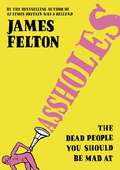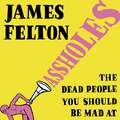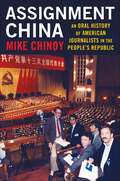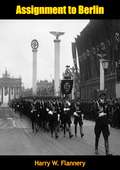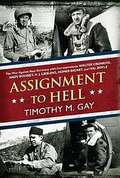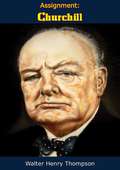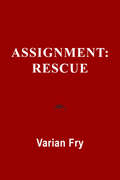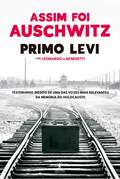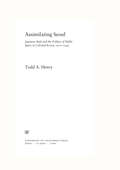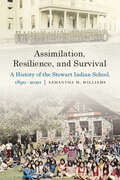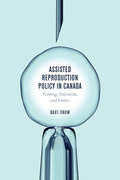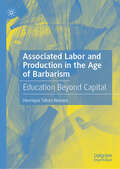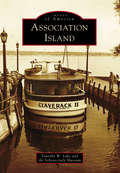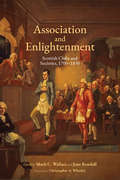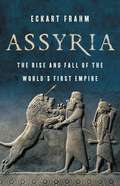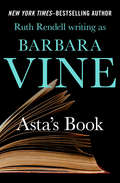- Table View
- List View
Assholes
by James FeltonIn this, er, 'unique' illustrated potted history of the human race, Twitter icon James Felton uses his inimitable brand of banter to unveil the slyest, creepiest and/or nastiest specimens who've ever lived.Enter the 16th Century Chinese Emperor Zhegende, whose harem was so big some of the women within it died of starvation, King Charles II's executioner who would only give you a clean beheading if you paid properly for it beforehand, and llya Ivanovich Ivanov, the 19th Century scientist who was a mega asshole and if you buy the book you'll find out why.Darkly funny, highly informative and always unbelievable, these are the dead people you should be mad at.
Assholes
by James FeltonIn this, er, 'unique' illustrated potted history of the human race, Twitter icon James Felton uses his inimitable brand of banter to unveil the slyest, creepiest and/or nastiest specimens who've ever lived.Enter the 16th Century Chinese Emperor Zhegende, whose harem was so big some of the women within it died of starvation, King Charles II's executioner who would only give you a clean beheading if you paid properly for it beforehand, and llya Ivanovich Ivanov, the 19th Century scientist who was a mega asshole and if you buy the book you'll find out why.Darkly funny, highly informative and always unbelievable, these are the dead people you should be mad at.
Assholes
by James FeltonRead by Russell KaneIn this, er, 'unique' illustrated potted history of the human race, Twitter icon James Felton uses his inimitable brand of banter to unveil the slyest, creepiest and/or nastiest specimens who've ever lived.Enter the 16th Century Chinese Emperor Zhegende, whose harem was so big some of the women within it died of starvation, King Charles II's executioner who would only give you a clean beheading if you paid properly for it beforehand, and llya Ivanovich Ivanov, the 19th Century scientist who was a mega asshole and if you buy the book you'll find out why.Darkly funny, highly informative and always unbelievable, these are the dead people you should be mad at.
Assignment China: An Oral History of American Journalists in the People's Republic
by Mike ChinoyReporting on China has long been one of the most challenging and crucial of journalistic assignments. Foreign correspondents have confronted war, revolution, isolation, internal upheaval, and onerous government restrictions as well as barriers of language, culture, and politics. Nonetheless, American media coverage of China has profoundly influenced U.S. government policy and shaped public opinion not only domestically but also, given the clout and reach of U.S. news organizations, around the world.This book tells the story of how American journalists have covered China—from the civil war of the 1940s through the COVID-19 pandemic—in their own words. Mike Chinoy assembles a remarkable collection of personal accounts from eminent journalists, including Stanley Karnow, Seymour Topping, Barbara Walters, Dan Rather, Melinda Liu, Nicholas Kristof, Joseph Kahn, Evan Osnos, David Barboza, Amy Qin, and Megha Rajagopalan, among dozens of others. They share behind-the-scenes stories of reporting on historic moments such as Richard Nixon’s groundbreaking visit in 1972, China’s opening up to the outside world and its emergence as a global superpower, and the crackdowns in Tiananmen Square and Xinjiang. Journalists detail the challenges of covering a complex and secretive society and offer insight into eight decades of tumultuous political, economic, and social change.At a time of crisis in Sino-American relations, understanding the people who have covered China for the American media and how they have done so is crucial to understanding the news. Through the personal accounts of multiple generations of China correspondents, Assignment China provides that understanding.
Assignment Rescue: An Autobiography
by Varian FryThe Gestapo's blacklist was thousands of names long.... How many people could he get out before Hitler sealed the frontiers? Varian Fry didn't know any more about being an undercover agent than what he'd seen in the movies. But he was the one man who could get into Vichy France, where thousands of people had fled Hitler's Germany. Unless he could get them out, they'd be trapped--turned back to the concentration camps and death camps. An exciting, true story of World War II--Varian Fry describes the methods he used to get thousands of hunted men and women to safety.
Assignment to Berlin
by Harry W. FlanneryBy the man who succeeded William L. Shirer as the Berlin correspondent of the Columbia Broadcasting System, Assignment to Berlin by U.S. journalist and author Harry W. Flannery, first published in 1942, covers Germany in the crucial year 1941.Packed with lively incident, shrewd comment and startling information, it brings the story of life in Hitler’s domain up to the eve of America’s entry into the war.
Assignment to Hell: The War Against Nazi Germany with Correspondents Walter Cronkite, Andy Rooney, A. J. Liebling, Homer Bigart, and Hal Boyle
by Timothy M. GayTHEIR WORK ON THE FRONT LINES MADE HEADLINES In February 1943, a group of journalists—including a young wire service correspondent named Walter Cronkite and cub reporter Andy Rooney—clamored to fly along on a bombing raid over Nazi Germany. Seven of the sixty-four bombers that attacked a U-boat base that day never made it back to England. A fellow survivor, Homer Bigart of the New York Herald Tribune, asked Cronkite if he’d thought through a lede. “I think I’m going to say,” mused Cronkite, “that I’ve just returned from an assignment to hell. ” During his esteemed career Walter Cronkite issued millions of words for public consumption, but he never wrote or uttered a truer phrase. Assignment to Hell tells the powerful and poignant story of the war against Hitler through the eyes of five intrepid reporters. Crisscrossing battlefields, they formed a journalistic band of brothers, repeatedly placing themselves in harm’s way to bring the war home for anxious American readers. Cronkite crashed into Holland on a glider with U. S. paratroopers. Rooney dodged mortar shells as he raced across the Rhine at Remagen. Behind enemy lines in Sicily, Bigart jumped into an amphibious commando raid that nearly ended in disaster. The New Yorker’s A. J. Liebling ducked sniper fire as Allied troops liberated his beloved Paris. The Associated Press’s Hal Boyle barely escaped SS storm troopers as he uncovered the massacre of U. S. soldiers during the Battle of the Bulge. Assignment to Hell is a stirring tribute to five of World War II’s greatest correspondents and to the brave men and women who fought on the front lines against fascism—their generation’s “assignment to hell. ” .
Assignment: Churchill
by Walter Henry ThompsonAN UNIQUE, INTIMATE VIEW OF WINSTON CHURCHILL BY THE MAN WHO GUARDED HIM NIGHT AND DAY FOR 20 MOMENTOUS YEARS.When Tommy Thompson as assigned to guard Winston Churchill by Scotland Yard he shuddered. Churchill was considered a tough assignment and Thompson had had his share of tough ones. From Lloyd George to King Alexander of Yugoslavia. But he did it for almost 20 years.Here is a delightful intimate view of the great statesman and his contemporaries—Lawrence of Arabia, F.D.R., Joseph Stalin, seen with the well-trained eye of a Scotland Yard man.“As intimate a portrait of Churchill as has ever been committed to print.”—San Francisco Chronicle“A supremely colorful man, chewing on his dead cigars striking matches on the walls of the kremlin parading naked before an embarrassed President Roosevelt—indifferent to the lesser things in life, but never missing the main chances of his destiny.”—New York Times“Gripping...Churchill’s biographers will unquestionably have to draw on this book by the officer who was the great man’s shadow for 20 years.”—Saturday Review Syndicate“If it’s suspense and excitement you seek in a book...just read ASSIGNMENT: CHURCHILL.”—Los Angeles Times
Assignment: Oswald
by Thomas Hosty James P. HostySpecial Agent James Hosty began investigating Lee Harvey Oswald in October 1963, a full month before the JFK assassination. From November 22 on, Hosty watched as everyone from the Dallas Police, the FBI, the CIA, Naval Intelligence, and the State Department up through the Warren Commission to J. Edgar Hoover, Robert Kennedy, and Lyndon Johnson reacted to and manipulated the facts of the president's assassination--until Hosty himself became their scapegoat. After seeing his name appear in three inconclusive federal investigations and countless fact-twisting conspiracy theories (including Oliver Stone's motion picture), Hosty decided to tell his own story.Assignment: Oswald is the authoritative insider's account of one of our country's most traumatic events. Combining his own unique, intimate knowledge of the case with previously unavailable government documents--including top secret CIA files recently released from the National Archives--Hosty tells the true story behind the assassination and the government's response to it, including the suppression of a documented Oswald-Soviet-Castro connection. Hosty offers an exclusive insider's knowledge of the mechanisms, the power structures, and the rivalries in and among the various intelligence and law enforcement agencies and why they have determined who knows what about the assassination. Here, at last, is an unmistakably expert and responsible account of the murder of President Kennedy.
Assignment: Rescue
by Albert O. Hirschman Varian FryMarseilles, France...August, 1940 The Gestapo's blacklist was thousands of names long...How many people could he get out before Hitler sealed the frontiers? Varian Fry didn't know any more about being an undercover agent than what he'd seen in the movies. But, he was the one man who could get into Vichy France, where thousands of people had fled Hitler's Germany. Unless he could get them out, they'd be trapped-turned back to the concentration camps and death camps. An exciting, true story of World War II - Varian Fry describes the methods he used to get thousands of hunted men and women to safety.
Assim foi Auschwitz
by Primo LeviTestemunho inédito de uma das vozes mais relevantes da memória do Holocausto. «Somos homens, pertencemos à mesma família humana a que pertencem os nossos carrascos. [...] Somos filhos dessa Europa onde está Auschwitz.» Em 1945, no rescaldo do fim da Guerra e da libertação dos campos de concentração pelas forças aliadas, o exército soviético pediu a Primo Levi e a Leonardo De Benedetti, seu companheiro de campo, que redigissem uma relação pormenorizada das condições de vida nos Lager. O resultado foi um dos primeiros relatórios alguma vez realizados sobre os campos de extermínio. Chocante pela objectividade e detalhe, tocante pela precoce e indignada lucidez, é um testemunho extraordinário daquela que viria a ser uma das vozes mais relevantes da antologia de memórias sobre o Holocausto. Assim foi Auschwitz recolhe esse relatório e vários outros textos de Primo Levi - inéditos até hoje - sobre a experiência colectiva do Holocausto, compondo um mosaico de memórias e reflexões críticas de inestimável valor histórico e humano, tão relevantes hoje, setenta anos volvidos sobre o fim da Segunda Guerra, como no tempo em que foram escritos. «A nossa esperança é que tudo o que aqui foi documentado seja visto e lembrado como uma aberração a não repetir até ao futuro mais longínquo. A esperança de todos os homens é que estas imagens sejam vistas como um fruto horrendo, mas isolado, da tirania e do ódio: que se identifiquem as suas raízes na grande parte da história sangrenta da Humanidade, mas que o fruto não dê novas sementes,nem amanhã nem nunca.»
Assim foi Auschwitz
by Primo LeviTestemunho inédito de uma das vozes mais relevantes da memória do Holocausto. FORMATO DE BOLSO, NUMA EDIÇÃO CUIDADA (CAPA DURA). Em 1945, no rescaldo do fim da Guerra e da libertação dos campos de concentração pelas forças aliadas, o exército soviético pediu a Primo Levi e a Leonardo De Benedetti, seu companheiro de campo, que redigissem uma relação pormenorizada das condições de vida nos Lager. O resultado foi um dos primeiros relatórios alguma vez realizados sobre os campos de extermínio. Chocante pela objectividade e detalhe, tocante pela precoce e indignada lucidez, é um testemunho extraordinário daquela que viria a ser uma das vozes mais relevantes da antologia de memórias sobre o Holocausto.Assim foi Auschwitz recolhe esse relatório e vários outros textos de Primo Levi - inéditos até hoje - sobre a experiência colectiva do Holocausto, compondo um mosaico de memórias e reflexões críticas de inestimável valor histórico e humano, tão relevantes hoje, setenta anos volvidos sobre o fim da Segunda Guerra, como no tempo em que foram escritos. «A nossa esperança é que tudo o que aqui foi documentado seja visto e lembrado como uma aberração a não repetir até ao futuro mais longínquo. A esperança de todos os homens é que estas imagens sejam vistas como um fruto horrendo, mas isolado, da tirania e do ódio: que se identifiquem as suas raízes na grande parte da história sangrenta da Humanidade, mas que o fruto não dê novas sementes,nem amanhã nem nunca.»
Assimilating Seoul
by Todd A. HenryAssimilating Seoul, the first book-length study written in English about Seoul during the colonial period, challenges conventional nationalist paradigms by revealing the intersection of Korean and Japanese history in this important capital. Through microhistories of Shinto festivals, industrial expositions, and sanitation campaigns, Todd A. Henry offers a transnational account that treats the city's public spaces as "contact zones," showing how residents negotiated pressures to become loyal, industrious, and hygienic subjects of the Japanese empire. Unlike previous, top-down analyses, this ethnographic history investigates modalities of Japanese rule as experienced from below. Although the colonial state set ambitious goals for the integration of Koreans, Japanese settler elites and lower-class expatriates shaped the speed and direction of assimilation by bending government initiatives to their own interests and identities. Meanwhile, Korean men and women of different classes and generations rearticulated the terms and degree of their incorporation into a multiethnic polity. Assimilating Seoul captures these fascinating responses to an empire that used the lure of empowerment to disguise the reality of alienation.
Assimilation, Resilience, and Survival: A History of the Stewart Indian School, 1890–2020 (Indigenous Education)
by Samantha M. WilliamsAssimilation, Resilience, and Survival illustrates how settler colonialism propelled U.S. government programs designed to assimilate generations of Native children at the Stewart Indian School (1890–1980). The school opened in Carson City, Nevada, in 1890 and embraced its mission to destroy the connections between Native children and their lands, isolate them from their families, and divorce them from their cultures and traditions. Newly enrolled students were separated from their families, had their appearances altered, and were forced to speak only English. However, as Samantha M. Williams uncovers, numerous Indigenous students and their families subverted school rules, and tensions arose between federal officials and the local authorities charged with implementing boarding school policies. The first book on the history of the Stewart Indian School, Assimilation, Resilience, and Survival reveals the experiences of generations of Stewart School alumni and their families, often in their own words. Williams demonstrates how Indigenous experiences at the school changed over time and connects these changes with Native American activism and variations in federal policy. Williams&’s research uncovers numerous instances of abuse at Stewart, and Assimilation, Resilience, and Survival addresses both the trauma of the boarding school experience and the resilience of generations of students who persevered there under the most challenging of circumstances.
Assisted Reproduction Policy in Canada: Framing, Federalism, and Failure
by Dave SnowThe world has undergone a revolution in assisted reproduction, as processes such as in vitro fertilization, embryonic screening, and surrogacy have become commonplace. Yet when governments attempt to regulate this field, they have not always been successful. Canada is a case in point: six years after the federal government created comprehensive legislation, the Supreme Court of Canada struck it down for violating provincial authority over health. In Assisted Reproduction Policy in Canada, Dave Snow provides the first historical exploration of Canadian assisted reproduction policy, from the 1989 creation of the Royal Commission on New Reproductive Technologies to the present day. Snow argues the federal government’s policy failure can be traced to its contradictory "policy framing," which sent mixed messages about the purposes of the legislation. In light of the federal government’s diminished role, Snow examines how other institutions have made policy in this emerging field. Snow finds provincial governments, medical organizations, and even courts have engaged in considerable policymaking, particularly with respect to surrogacy, parentage, and clinical intervention. The result—a complex field of overlapping and often conflicting policies—paints a fascinating portrait of different political actors and institutions working together. Accessibly written yet comprehensive in scope, Assisted Reproduction Policy in Canada highlights how paying attention to multiple policymakers can improve our knowledge of health care regulation.
Assize of Arms: The Disarmament of Germany and Her Rearmament (1919-1939)
by J. H. MorganBritish lawyer and Brigadier-General John Hartman Morgan served as Deputy Adjutant-General in Berlin from 1919-1923 at the Inter-Allied Military Commission of Control—a term used in a series of peace treaties concluded after World War I (1914-1918) between different countries. Each of these treaties was concluded between the Principal Allied and Associated Powers (consisting of the United States of America, the British Empire, France, Italy and Japan) on the one hand, and one of the Central Powers like Germany, Turkey or Bulgaria.One of the terms of such treaties required conversion of all of the Central Powers’ military and armaments related production and related facilities into purely commercial use. The decision and the modus operandi to ensure this rested with a Military Inter-Allied Commission of Control. The Military Inter-Allied Commission of Control was also entrusted with a number of other responsibilities, including (a) setting the number of customs officials, local urban and rural police, forest guards and other officials under the control of the Government of the central power concerned; and (b) receiving information relating to the location of the stocks and depots of arms, munitions and war material and their operations.It was during this period of 1919-1923 that Brig.-Gen. Morgan witnessed German attempts to build up their army contravening the terms of the Treaty of Versailles, and he published his findings in October 1924 in the Quarterly Review, titled “The Disarmament of Germany and After.” However, it would not be until after World War II that he would decide to elaborate on this theme—the result is the present volume, Assize of Arms: The Disarmament of Germany and Her Rearmament (1919-1939).First published in 1945, it was intended to be published in two volumes; however, owing to Brig.-Gen. Morgan’s passing in 1955, it remained as a single volume.A valuable addition to any World Wars library.
Associated Labor and Production in the Age of Barbarism: Education Beyond Capital
by Henrique Tahan NovaesThe book focuses on different practices of associated labor in Brazil and Argentina, in the case of the workers’ recuperated factories, over the past 40 years. Novaes analyses labor practices from a critical Marxist perspective as a reaction to the misery of neoliberalism. Deindustrialization, austerity programs, increasing commodification and international competitiveness have severely deteriorated the living and working conditions of the majority of Latin Americans. However, alternative labor, production and educational practices have developed in this increasingly ruthless neoliberal capitalism. Although they are still small, they indicate a potential way out of the capitalist mode of production. Novaes directs his special attention to the “education beyond capital,” which has accompanied these alternative labor and production practices (from alternative job training in recuperated companies and the movement of landless rural workers MST).
Association Football and English Society, 1863-1915 (Routledge Soccer Histories)
by Tony MasonAssociation football, as it developed rapidly in the late-nineteenth and early-twentieth centuries, both reflected British society and helped to reshape it. In this newly released edition of Tony Mason’s essential account of the game’s rise, focusing on issues such as the amateur–professional divide, social class and mass spectatorship are seen as fundamental to our understanding of what is now a global phenomenon. Dilwyn Porter supplements this classic text with a brand new introduction.
Association Football: A Study in Figurational Sociology (Routledge Research in Sports History)
by Eric Dunning Graham CurryThis book presents a synthesis of the work on early football undertaken by the authors over the past two decades. It explores aspects of a figurational approach to sociology to examine the early development of football rules in the middle part of the nineteenth century. The book tests Dunning’s status rivalry hypothesis to contest Harvey’s view of football’s development which stresses an influential sub-culture outside the public schools. Status Rivalry re-states the primacy of these latter institutions in the growth of football and without it the sport’s story would remain skewed and unbalanced for future generations.
Association Island
by Schenectady Museum Timothy W. LakeMost people believe the General Electric retreat at Association Island was organized by GE. In reality, it was originally formed by several businessmen from the incandescent lamp industry; these men formed an association of lamp companies to compete with GE. A 1903 fishing trip to Henderson Harbor inspired them to purchase the island for their summer sojourns; however, ownership of the association and the island were eventually absorbed by GE, turning it into a full-scale resort for executives and managers of the ever-expanding corporation. Hotels, restaurants, garages, boats, fishing guides, managers, and maintenance workers from nearby Henderson Harbor were all tied to Association Island for the next 50 years. When GE gave it away, Association Island fell into a long and steady period of decline until it was turned into a camping resort for the 21st century. Association Island illustrates the financial and social impact of a significant corporation on a small fishing community.
Association and Enlightenment: Scottish Clubs and Societies, 1700-1830 (Studies in Eighteenth-Century Scotland)
by Bob Harris David Allan Rosalind Carr James J. Caudle Rhona Brown Jacqueline Jenkinson Ralph McLean Corey Andrews Martyn PowellSocial clubs as they existed in eighteenth- and early nineteenth-century Scotland were varied: they could be convivial, sporting, or scholarly, or they could be a significant and dynamic social force, committed to improvement and national regeneration as well as to sociability. The essays in this volume—the first full-length study of the subject in fifty years—examine the complex history of clubs and societies in Scotland from 1700 to 1830. Contributors address attitudes toward associations, their meeting-places and rituals, their links with the growth of the professions and with literary culture, and the ways in which they were structured by both class and gender. By widening the context in which clubs and societies are set, this volume offers a new framework for understanding them, bringing together the inheritance of the Scottish past, the unique and cohesive polite culture of the Scottish Enlightenment, and the broader context of associational patterns common to Britain, Ireland, and beyond.
Associations and Law: The Classical and Early Christian Stages
by Otto Gierke George HeimanGeorge Heiman has translated the discussion of classical and early Christian laws of association from the major works by Grotto Gierke, Das deutsche Genossenschaftsrecht. This work complements F.W. Maitland's translation of a later part under the title, The Political Theories of the Middle Ages, and E. Barker's translation of the third part, Natural Law and the Theory of Society, 1500-1800. Professor Heiman thus has completed the circle in bringing into English the eminent German jurist's historical analysis of the law. Professor Heiman furthermore has introduced the work with substantial, detailed, and scholarly essays on Gierke's work as a whole. He examines and explains Gierke's concept of the group-person and his organic view of the association, society, and the state, and clearly outlines the conflict between individualist Roman and collectivist Germanic law. This introduction provides the first complete analysis in English of the philosophy of a major representative of the school of historical law and a jurist whose thinking is reflected in the general civil code adopted in Germany at the end of the nineteenth century. The book will interest political and social theorists as well as those concerned with jurisprudence and legal philosophy.
Assyria: The Rise and Fall of the World's First Empire
by Eckart FrahmA new history of Assyria, the ancient civilization that set the model for future empires At its height in 660 BCE, the kingdom of Assyria stretched from the Mediterranean Sea to the Persian Gulf. It was the first empire the world had ever seen. Here, historian Eckart Frahm tells the epic story of Assyria and its formative role in global history. Assyria&’s wide-ranging conquests have long been known from the Hebrew Bible and later Greek accounts. But nearly two centuries of research now permit a rich picture of the Assyrians and their empire beyond the battlefield: their vast libraries and monumental sculptures, their elaborate trade and information networks, and the crucial role played by royal women. Although Assyria was crushed by rising powers in the late seventh century BCE, its legacy endured from the Babylonian and Persian empires to Rome and beyond. Assyria is a stunning and authoritative account of a civilization essential to understanding the ancient world and our own.
Assyrians in Modern Iraq: Negotiating Political and Cultural Space
by Alda BenjamenExamining the relationship between a strengthened Iraqi state under the Baʿth regime and the Assyrians, a Christian ethno-religious group, Alda Benjamen studies the role of minorities in twentieth-century Iraqi political and cultural history. Relying on extensive research in Iraq, including sources uncovered at the Iraqi National Archives in Baghdad, as well as in libraries and private collections in Erbil, Duhok, and Mosul, in Arabic and modern Aramaic, Benjamen foregrounds the Iraqi periphery as well as the history of bilingualism to challenge the monolingual narrative of the state. By exploring the role of Assyrians in Iraq's leftist and oppositional movements, including gendered representations of women, she demonstrates how, within newly politicized urban spaces, minorities became attracted to intellectual and political movements that allowed them to advance their own concerns while engaging with other Iraqis of their socio-economic background and relying on transnational community networks. Assyrian intellectuals not only negotiated but also resisted government policies through their cultural production, thereby achieving a softening of Baʿthist policies towards the Assyrians that differed markedly from those of later repressive eras.
Asta's Book
by Ruth RendellAn &“obsessively readable&” mystery from the New York Times–bestselling author of Dark Corners about a century-old diary that holds clues to a murder (The Sunday Telegraph). Asta Westerby is lonely. In 1905, shortly after coming to East London from Denmark with her husband and their two little boys, she feels like a stranger in a strange land. And it doesn&’t help that her husband is constantly away on business. Fortunately, she finds solace in her diary—and she continues to do so until 1967. Decades later, her granddaughter, Ann, finds the journal, and it becomes a literary sensation, offering an intimate view of Edwardian life. But it also appears to hold the key to an unsolved murder and the disappearance of a child. A modern masterpiece by the Edgar Award–winning author of the Inspector Wexford Mysteries, and an excellent choice for readers of P. D. James, Ian Rankin, or Scott Turow, Asta&’s Book is at once a crime story, a historical novel, and a psychological portrait told through the diary itself and through Ann, who is bent on unlocking the journal&’s excised mystery.
